|
|
Richards J. M. An introduction to modern architecture. — Baltimore, 1962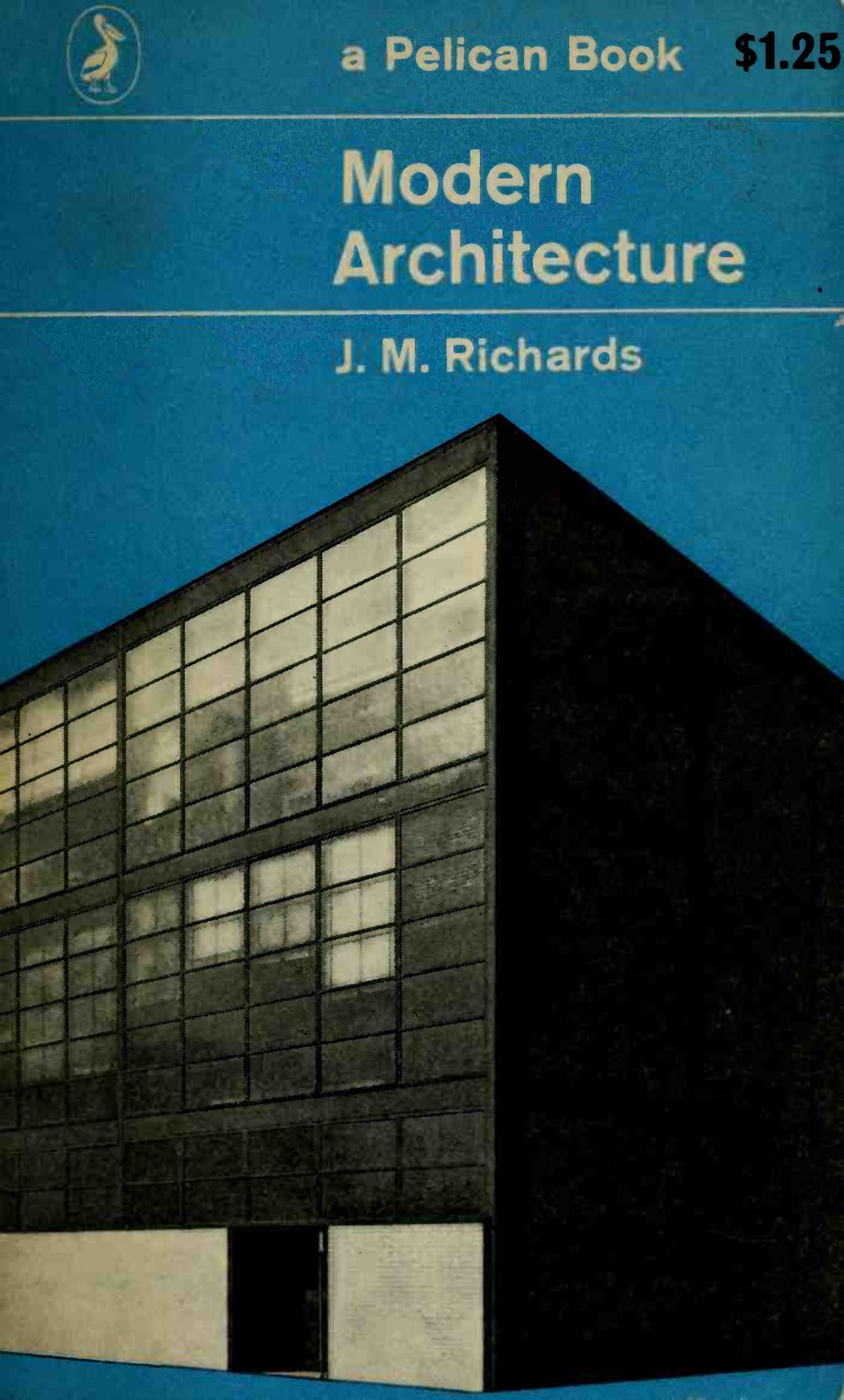 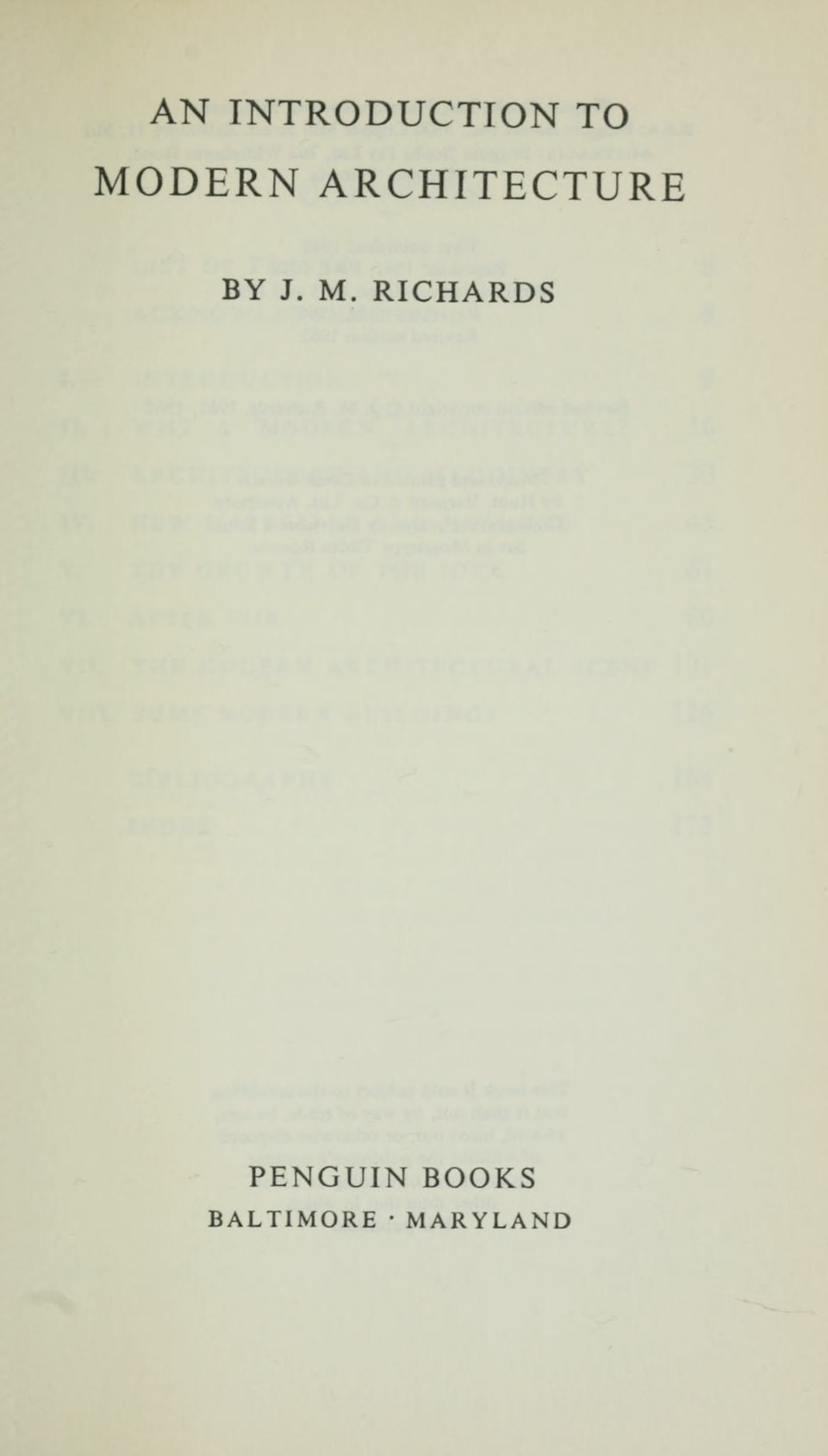 An introduction to modern architecture / J. M. Richards. — Revised edition. — Baltimore, Maryland : Penguin Books, 1962. — 185 p., 48 pl. : ill.
An Introduction to Modern Architecture, which has been newly revised and brought up to date, sets out to explain what ‘modern’ architecture is all about. In these days, when the need for new buildings is so great and so many building plans are being made, it is specially important that everyone should have an understanding of the principles of architecture, and the author, disapproving of the treatment of architecture as a professional mystery or merely a matter of correct taste, asks (and tries to answer) the simple question: ‘Conventions and habits apart, what sort of architecture does our time really require?’
With the help of gravure illustrations, as well as line drawings, he explains how modern buildings come to look as they do, discussing the technical practices and the changing needs and ideals on which modern architects’ work is based. Also, believing that architecture can only be explained as part of a continuous growth, he shows modern architecture against the background out of which it grew, giving an outline history of the struggle to produce a sane architecture, which has been going on throughout the past hundred years.
J. M. Richards, who was born in 1907, trained as an architect in London, and studied and worked at it afterwards in Canada, the U.S.A., London, and Dublin. But in 1933 he gave up the practice of architecture to become a journalist and critic and was successively assistant editor of the Architects' Journal and the Architectural Review. During the war he worked for the Ministry of Information, most of the time in the Middle East, where he was Director of Publications. After the war he returned to the Architectural Review, of which he is now editor. He is also a frequent broadcaster on sound and television and a member of the Royal Fine Art Commission. He has been visiting Professor of Architecture at Leeds University and was made a C.B.E. in 1959. Besides many articles on art and architecture in English and foreign periodicals, he has written several other books, including A Miniature History of the English House, The Castles on the Ground, and The Functional Tradition in Early Industrial Buildings; and he has edited a book on New Buildings in the Commonwealth.
CHAPTER IINTRODUCTION
The words ‘modern architecture’ are used here to mean something more particular than contemporary architecture. They are used to mean the new kind of architecture that is growing up with this century as this century’s own contribution to the art of architecture; the work of those people, whose number is happily increasing, who understand that architecture is a social art related to the life of the people it serves, not an academic exercise in applied ornament. The question that immediately arises, whether there is in fact enough difference between people’s lives as they are lived in this century and as they were lived in previous centuries to justify a truly ‘modern’ architecture being very different from that of the past – and indeed whether ‘modern’ architecture is quite as revolutionary as it is supposed to be – must be discussed later.
But there can be no denying that examples of an architecture entirely different from what our fathers were accustomed to have appeared on the scene during the last twenty years, following their appearance in other countries during perhaps twice that period. And there can be no denying that the designers of these buildings are extremely sincere. They are not, as their detractors often suggest, ‘Bolshies’ or stunt-mongers. They have thought things out very thoroughly, and they believe that the new architecture that we are calling ‘modern’ (henceforward we will drop the quotation marks) is something that is needed in the world today. They believe also that in developing and perfecting it so as to answer this century’s problems and to be in tune with its outlook, they are helping at the revival of architecture as a live art – something that even those who find it difficult to admire the form the new architecture is taking admit that it had not been for many years previously. For it is a mistake to suppose that, because modern architects are particularly concerned to relate buildings more closely to the needs they have to serve, they are only interested in the practical side of architecture. They know that they are practising an art, and are therefore concerned with the pursuit of beauty. They feel however that it is time we made clear the difference between beauty itself and the merely conventional forms that habit has made us associate with it. But that also is a question that we must discuss later.
All this, in any case, is what the modern architects themselves think; they have had to fight to get this viewpoint accepted, because it was natural for the man in the street to see in the new architecture only another bewildering addition to the variety of architectural styles already offered him: a new style which, he felt, must have something to it, because it looked clean and efficient and not too pompous and because he had heard that it is based on an idea called functionalism (or ‘fitness for purpose’) which at least sounded sensible if rather inhuman; but a style that he also rather suspected, simply because he is naturally conservative. He dislikes having something familiar replaced by something unfamiliar without very evident reason, and he had an idea – in fact he still has – that the people who are responsible for the new architecture are cranks, foreigners, revolutionaries, or other kinds of people that he disapproves of.
Nevertheless, modern architecture has been much better understood and appreciated in the last few years, and the purpose of this book is simply to try to enlarge understanding still further by describing to people who do not pretend to know anything about architecture, how these new buildings come to look as they do, why they are different for other reasons than for the sake of being different, and why their designers believe them to be the forerunners of a new architecture of the future.
There have been so many misunderstandings about modern architecture that before we begin to discuss what it is, it may be as well to mention a few things that it is not. It is not, for one thing, a fashionable style of jazz ornament; it is not the custom of building in concrete, or with flat roofs and horizontal window-panes; it is not ‘functionalism’. It is quite simply, like all good architecture, the honest product of science and art. It aims at once more relating methods of building as closely as possible to real needs. In fact it is nothing more or less than the exact modern equivalent of the architecture that flourished in previous ages, but fell into decay during the last century through architects having got out of touch with life and having forgotten what architecture was really for.
There are several other reasons why it is important just now for the man in the street to understand a little more what modern architecture is all about, besides the reason of satisfying his own curiosity and justifying the architects who produce it. One reason is that, like all movements that contain something new as well as something important, the modern movement in architecture acquired a following of imitators: vulgarizers who joined up with the movement only in order to cash in, as it were, on its news value. To this category belong all the makers of jazz-modem shop fronts in chromium plate and glass, all the purveyors of smart angular furniture and all the builders of nasty ‘modernistic’ villas; people who have no understanding of modern architecture’s ideals, but who could not have come into being without it. This bogus modernism, whether it is the result of the commercial exploitation of novelty or merely the wish to be in the fashion, has done great harm to the cause of good modern architecture by bringing it into disrepute. And the only way to prevent the fine ideals of the one from being vulgarized into insignificance by the other is for people to discriminate better between them. If people understand the point of genuine modern architecture and appreciate what it is trying to do, they will see quickly enough that the ungenuine – which is often called ‘modernistic’ – has no basis beyond itself. It consists only of a few flashy tricks and the use (often the wrong use) of a number of fashionable materials.
It will be objected that if the real modern architecture represents the revival of architecture as an art, and the bogus modern architecture is only a few flashy tricks, it should be easy enough to tell them apart, because the former will be beautiful and moving – in fact will have the qualities of a work of art – while the latter will appear what it is: trivial and vulgar. One answer is, unfortunately, that we cannot rely on our own good taste. The state of architecture and the design of nearly everything around us has sunk so low that we are no longer capable of judging what is good. We have become so bewildered by the various and meaningless structures that have been put up for a hundred years in the name of architecture, that we have ceased to look at buildings with the eyes with which one should look at a work of art. Instead we have become accustomed to look at the superficial trappings of architecture and admire them or otherwise as ornamentation – and even then not with our eyes but with our minds. We judge them according to a literary standpoint, and only think about whether they look imposing or romantic or antique, or whether they conform correctly to certain ‘styles’. Or else we do not look at all, but shrug our shoulders and say that we suppose these architects know what they are about; it is all very mysterious and professional. So one answer is that we simply have not the ability to discriminate about architecture, because we have no real aesthetic standards to judge by. In fact we have no taste, only habits – and generally bad habits. We shall acquire taste only by taking pains to develop our visual sensibility and our knowledge.
Another answer is that in all but a few cases even the best modern architecture has at present only a limited amount of positive appeal to our eyes. It will take time to get used to it; and, moreover, modern architects had at first to spend a large proportion of their energy eradicating the old bad habits from the practice of architecture. Having succeeded in getting away from the imitation of the styles of previous centuries, they were, and are, often content to be severely practical and aesthetically inoffensive. Perhaps, apart from wanting to proceed only one step at a time, they were anxious to begin by emphasizing the aspects of their own architecture that mark it most clearly as different from the kind that went before. For whatever reason, modern architecture has been passing through a sort of ‘puritan’ phase, in which the negative virtues of simplicity and efficiency have been allowed to dominate, and since 1939 a concentration on the essentials has also been necessitated in most countries by the overriding need to build cheaply. The important thing in the future is that modern architecture should blossom into full maturity without losing the sincerity which is at present its special virtue, or the inevitability which it gets from its appearance being so closely related to its structure. It must not become merely decorative: an imitation of itself.
Although more public understanding of the basis on which modern buildings are designed would make it far easier for a good standard of architecture to be established, it is nevertheless not suggested that good intention should be admitted as an excuse for bad performance, or that knowing how it got like that will make a bad building better. Architecture, besides being a social art, is a visual art, and aesthetic judgement must be independent of intellectual knowledge. But neither will it help to disparage the ideals of modern architecture on account of failings due to immaturity. That would only discourage perseverance.
One of the difficulties in writing this book is going to be that architecture cannot really be treated as a thing by itself. It merges imperceptibly, directly we begin to talk about its place in everyday life, into other subjects like housing, townplanning, transport, even politics (the private ownership of land, for example, is one of the things that make the orderly development of our towns – which constitutes the whole background of architecture – so difficult to achieve). It is also linked up with the other arts and crafts and with garden design and the design of furniture and textiles and all kinds of equipment, and with manufacturing processes. But all these subjects obviously cannot be dealt with in one book. So for our present purpose, although these subjects may be touched on in our arguments, we shall confine ourselves to the discussion of architecture in the sense of the design of separate buildings, although in regarding it thus we risk becoming guilty of the very mistake that modern architects are most careful to avoid; namely, that of dissociating individual buildings from their social setting, and thereby taking for granted things that on analysis we might find to be only conventions. The modern architect makes it part of his creed to accept no predetermined solution to a problem; never to design, that is to say, by rule of thumb, but to decide everything on its own merits.
At the moment we are in a position of questioning many things that we have previously taken for granted. To take one instance, modern town-planners are beginning to understand that it is not on ground of logic but of habit that we live in rows of houses either side of traffic routes, instead of, for example, in groups of houses placed in a park, with the through traffic going independently across country like the railways. In the same way it is probable that the conception of architecture (which is really a Victorian one) as consisting of a large number of unrelated buildings, will have disappeared from the world of the future, and we shall be able to study architecture whole. Today, however, we have but few opportunities of doing more than study scattered samples in the shape of individual buildings. Fuller discussion about the wider aspects of architecture and about the other subjects allied to it can be found in some of the books listed in the Bibliography.
Finally it may be mentioned that in this book it has not been thought necessary to give much space to the condemnation of the stupider architecture of recent years. Presumably all thinking people now agree that it is absurd to put up houses that look like miniature castles, petrol stations that look like medieval barns, and department stores that look like the palaces of Renaissance bishops – quite apart from being extremely inefficient. No arguments are needed against dressing up our buildings in fancy costumes borrowed from the past. A more profitable occupation is to give our undivided attention to the new architecture of the mid twentieth century which is at last evolving.
CONTENTS
LIST OF PLATES 6
ACKNOWLEDGEMENTS 8
I. INTRODUCTION 9
II. WHY A ‘MODERN’ ARCHITECTURE? 16
III. ARCHITECTURE AND MACHINERY 30
IV. NEW MATERIALS AND METHODS 45
V. THE GROWTH OF THE IDEA 61
VI. AFTER 1918 80
VII. THE MODERN ARCHITECTURAL SCENE 101
VIII. SOME MODERN BUILDINGS 126
BIBLIOGRAPHY 164
INDEX 173
Sample pages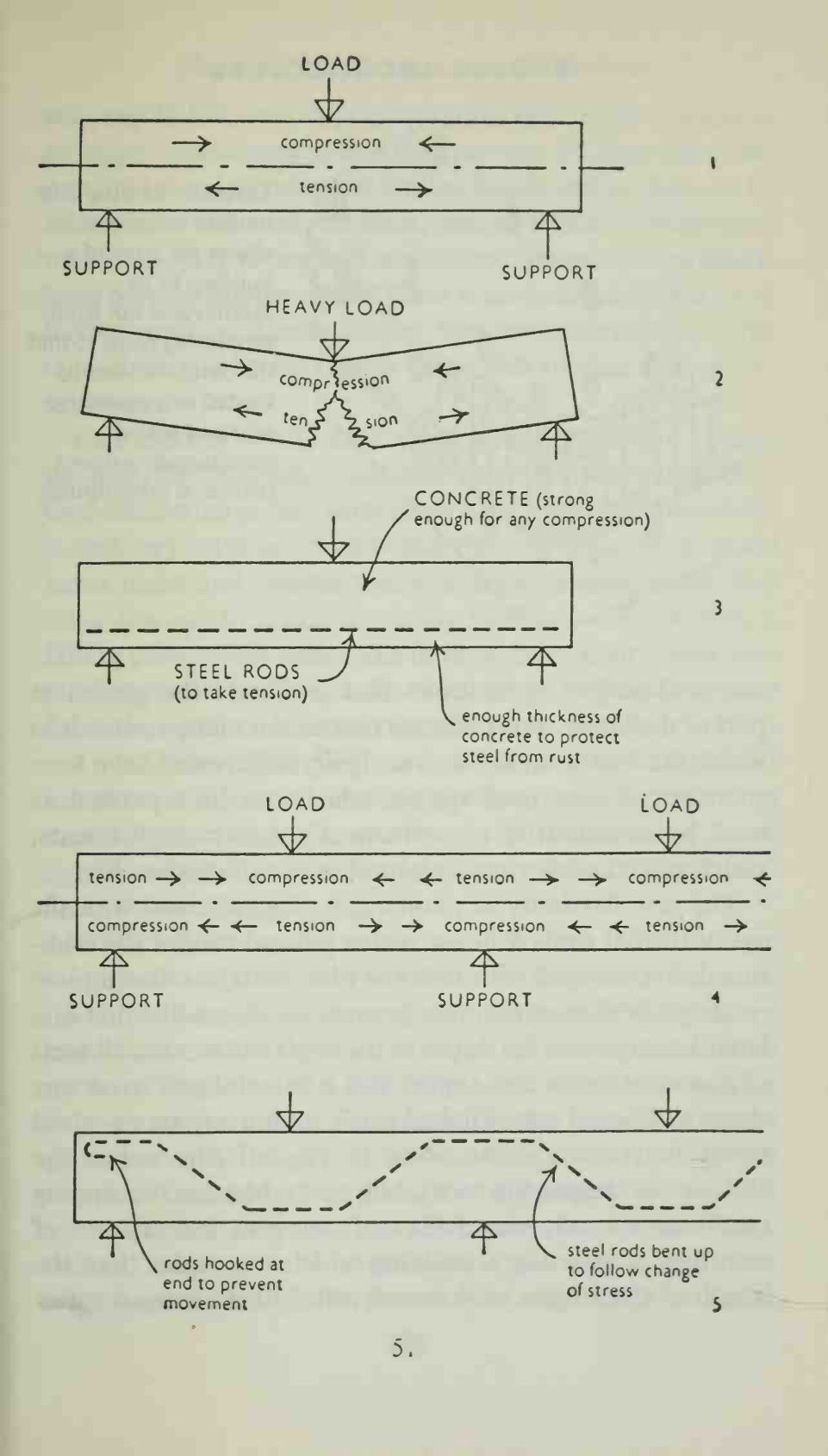 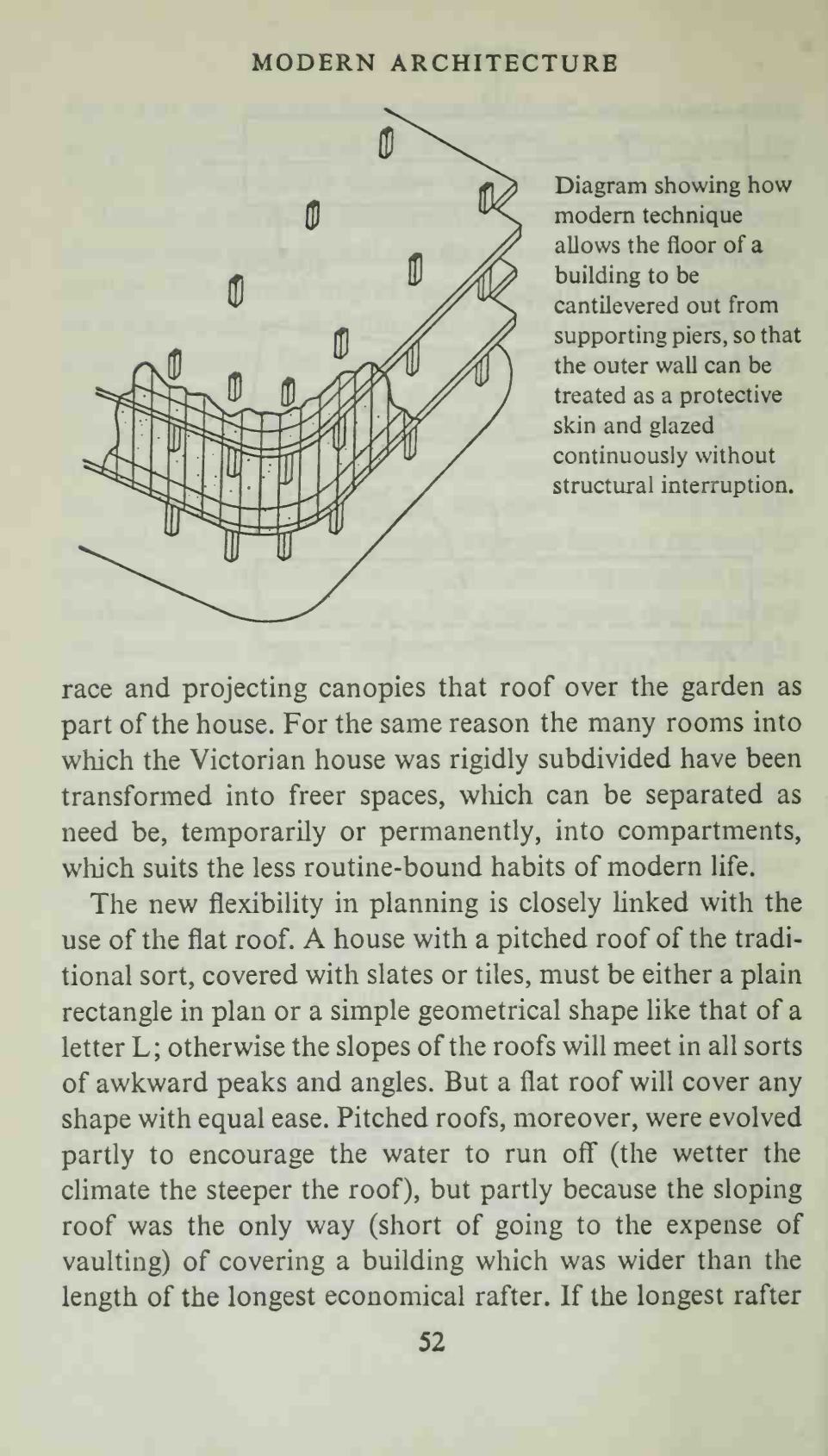 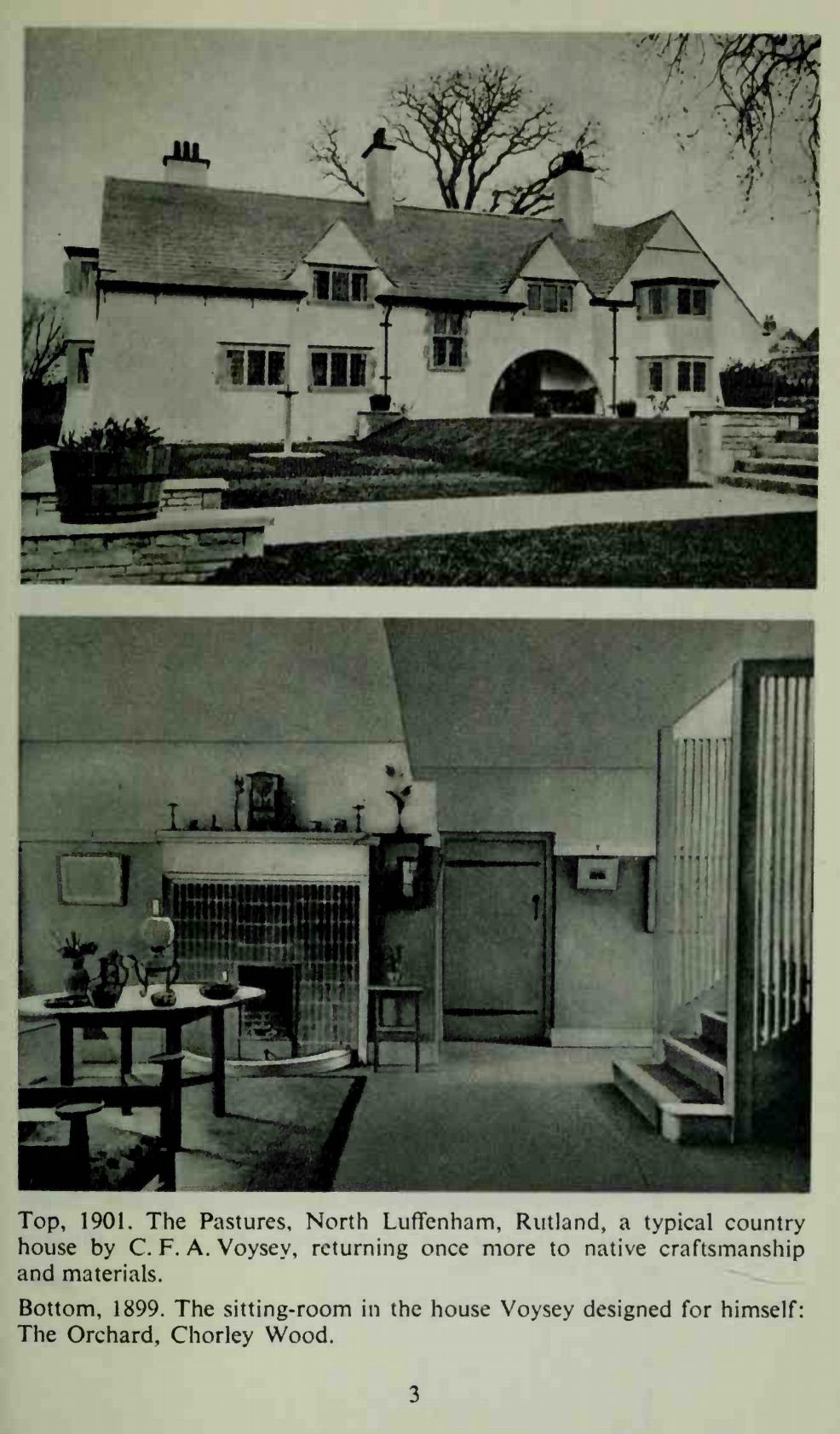 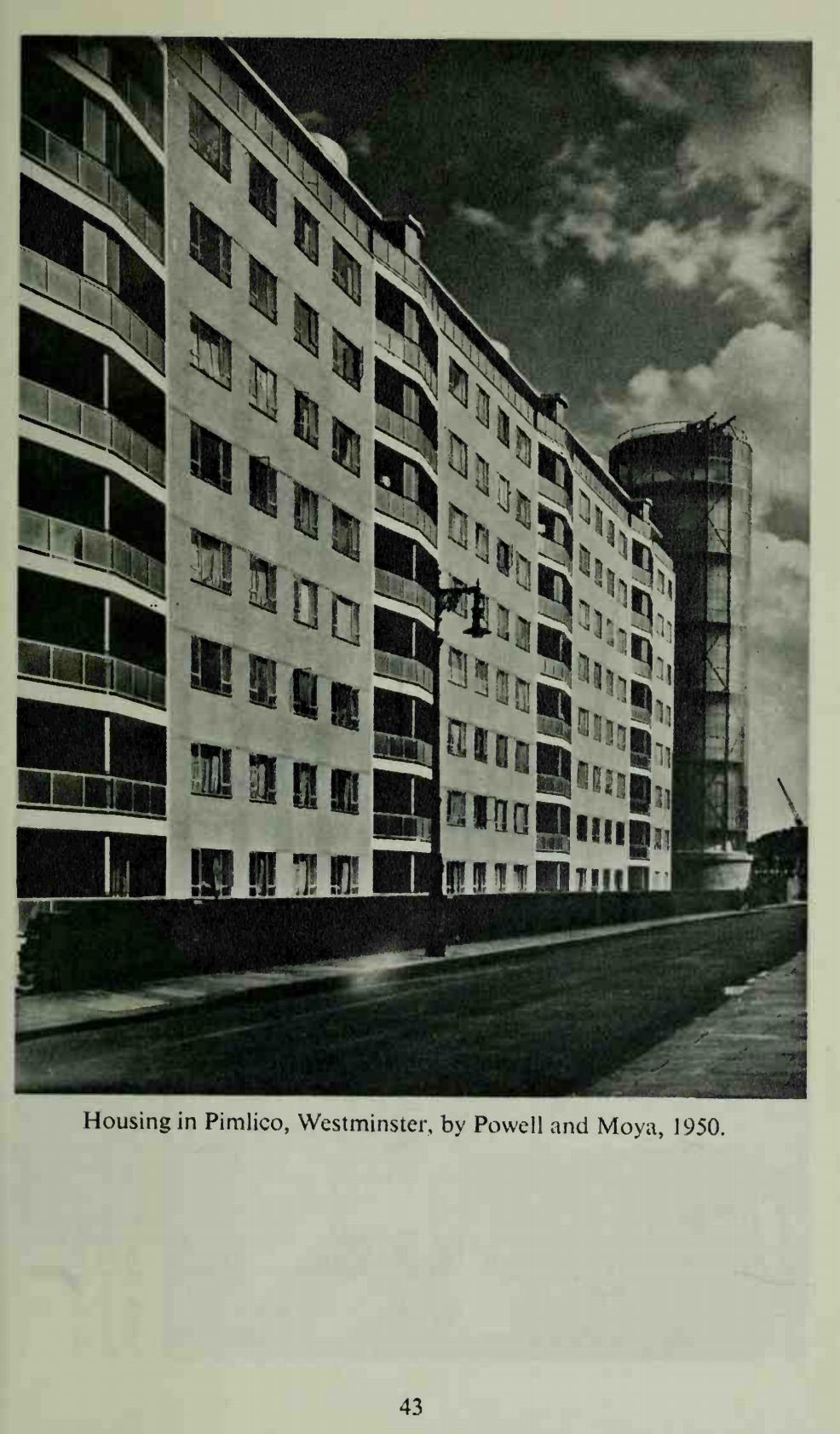
Download link (pdf, yandexdisk; 35,5 MB).
The electronic version of this issue is published only for scientific, educational or cultural purposes under the terms of fair use. Any commercial use is prohibited. If you have any questions about copyright, please send a letter to 42@tehne.com.
13 марта 2021, 17:05
0 комментариев
|
Партнёры
|





Комментарии
Добавить комментарий